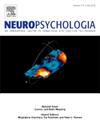Eyes wide open: Object-scene congruency and the pupillary response
IF 2
3区 心理学
Q3 BEHAVIORAL SCIENCES
引用次数: 0
Abstract
The pupil response has long been considered a robust marker of cognitive load. In the context of semantic processing, research has demonstrated that the pupil dilates in response to stimuli which violate contextual expectations (e.g. events presented out of chronological order). However, the scope of this relationship has yet to be fully elucidated. For example, incongruent object-scene relationships, while comprehensively explored by eye-tracking and electrophysiology research, have yet to be investigated via pupillometry. In this study, we measured pupil size in response to an object-scene congruency task. Participants were presented with a photorealistic background scene and instructed to fixate their gaze on a cued point within the scene. Upon recovery of pupil size to baseline, a congruent object (i.e. an object which fit into the overall meaning of the scene) or an incongruent object appeared at the cued fixation point for the remainder of each trial. We hypothesized that incongruent objects would result in greater mean pupil dilation from baseline than congruent objects, due to the increase in cognitive effort required for semantic processing of incongruent objects within a scene. Yet, in opposition to our hypothesis, the results of a time-course analysis revealed that pupil size was significantly greater for the congruent condition than the incongruent condition. The resulting implications for understanding pupil dilation as a physiological marker, both independently and in comparison to other markers, for high-level cognitive processes such as semantic integration are discussed.
睁大眼睛:物体-场景一致性和瞳孔反应。
长期以来,瞳孔反应一直被认为是认知负荷的有力标志。在语义处理的背景下,研究已经表明,瞳孔会对违反上下文预期的刺激做出反应(例如,按时间顺序呈现的事件)。然而,这种关系的范围尚未完全阐明。例如,不一致的物体-场景关系,虽然通过眼动追踪和电生理学研究进行了全面的探索,但尚未通过瞳孔测量法进行调查。在这项研究中,我们测量了瞳孔大小对物体-场景一致性任务的反应。研究人员向参与者展示了一个逼真的背景场景,并指示他们将目光固定在场景中的一个提示点上。当瞳孔大小恢复到基线时,在每次试验的剩余时间内,在提示注视点出现一个一致的物体(即符合场景整体含义的物体)或一个不一致的物体。我们假设,不一致的物体会导致比一致的物体更大的平均瞳孔扩张,因为在一个场景中,对不一致物体的语义处理需要增加认知努力。然而,与我们的假设相反,时间过程分析的结果显示,瞳孔尺寸在一致条件下明显大于不一致条件。本文还讨论了将瞳孔扩张作为一种生理标记来理解的结果,无论是独立的还是与其他标记相比较,瞳孔扩张对于语义整合等高级认知过程的影响。
本文章由计算机程序翻译,如有差异,请以英文原文为准。
求助全文
约1分钟内获得全文
求助全文
来源期刊

Neuropsychologia
医学-行为科学
CiteScore
5.10
自引率
3.80%
发文量
228
审稿时长
4 months
期刊介绍:
Neuropsychologia is an international interdisciplinary journal devoted to experimental and theoretical contributions that advance understanding of human cognition and behavior from a neuroscience perspective. The journal will consider for publication studies that link brain function with cognitive processes, including attention and awareness, action and motor control, executive functions and cognitive control, memory, language, and emotion and social cognition.
 求助内容:
求助内容: 应助结果提醒方式:
应助结果提醒方式:


